Difference between revisions of "Highly Effective Construction of Thematic Maps"
| Line 131: | Line 131: | ||
In order to change the color symbolization of the layers, we will start by selecting each reclassified layers one by one, followed by clicking on the <u>'Change styles'</u> button (painting palette icon). In the pop-up window, click on the <u>'Colour theming'</u> tab and then uncheck the <u>'Enable colour theming'</u> box. Now return back to the <u>'Rendering'</u> tab, before changing the <u>'Fill'</u> to a more appropriate color for each reclassified layer. |
In order to change the color symbolization of the layers, we will start by selecting each reclassified layers one by one, followed by clicking on the <u>'Change styles'</u> button (painting palette icon). In the pop-up window, click on the <u>'Colour theming'</u> tab and then uncheck the <u>'Enable colour theming'</u> box. Now return back to the <u>'Rendering'</u> tab, before changing the <u>'Fill'</u> to a more appropriate color for each reclassified layer. |
||
<br> |
<br> |
||
| − | <center>[[Image:Figure2.1.jpg|700px|]]</center> |
||
| − | |||
| − | <center>''Figure 2.1 shows how to navigate to Change Styles in OpenJUMP''</center> |
||
| − | |||
| − | <center>[[Image:Figure2.2.jpg|700px|]]</center> |
||
| − | |||
| − | <center>''Figure 2.2 shows the rendering preferences for contours''</center> |
||
| − | |||
| − | Once the colour theming is complete the output will be a final map product like Figure 2.8. This final map product makes it easy to interpret what is on the map in addition to being visually appealing. |
||
| − | |||
| − | <center>[[Image:Figure2.8.jpg|700px|]]</center> |
||
| − | |||
| − | <center>''Figure 2.8 shows the final map project developed in the example.''</center> |
||
| − | |||
| − | At this point adding a legend will help with interpreting the map. Right click the layer that would benefit from a legend (in the case of this project it will be for land use). Select Styles -> Save Legend (as shown in Figure 2.9). Save the legend somewhere memorable and then use the Add Files icon from Figure 1.2 to load in the Legend image. The image may end up far away from the map itself so use the method shown in Figure 1.4 to move it to the desired location. Once in place the end result should look like Figure 2.10 below. |
||
| − | |||
| − | <center>[[Image:Figure2.9.jpg|400px|]]</center> |
||
| − | |||
| − | <center>''Figure 2.9 shows how to save a legend for a layer''</center> |
||
| − | |||
| − | <center>[[Image:Figure2.10.jpg|700px|]]</center> |
||
| − | |||
| − | <center>''Figure 2.10 shows the final map product with a legend.''</center> |
||
| − | |||
| − | =='''Imported Files'''== |
||
| − | |||
<center>[[Image:Figure2.1.jpg|700px|]]</center> |
<center>[[Image:Figure2.1.jpg|700px|]]</center> |
||
Revision as of 21:53, 3 October 2019
OpenJUMP Tutorial by Thomas Brown - Revised by Didier Soeharjono
Contents
Introduction
About OpenJUMP
OpenJUMP is a Free and Open Source Software for Geospatial (FOSS4G) that is similar to other popular Geographic Information Systems (GIS) such as ArcGIS or QGIS. Originally founded by Vivid Solutions in 2002, this software was formerly known as JUMP (Java Unified Mapping Platform) before being discontinued in 2006. Since then, it has been renamed as OpenJUMP in recognition to the original Canadian development team, but also due to the fact that further contribution is open to the public. Nowadays, maintenance efforts are accomplished through The JUMP Pilot Program (JPP), an association committed to coordinating its development. The JPP consists of various separate organizations and global volunteer developers.
Languages
- Tamil
- French
- Czech
- Finnish
- Italian
- English
- Portuguese
- Telugu
- Malay
- Brazilian
- Portuguese
- Chinese (Simplified)
- German
- Japanese
- Spanish
- Hungarian
Intended Audience
- Non-Profit Organizations
- Government
- Science/Research
- Developers
- End Users/Desktop
- Agriculture
User Interface
- Java Swing
Programming Language
- Java
Capabilities
- Cross-platform compatibility with Windows, Linux, Unix, MacOSX (with Java installed)
- Read & write the following vector file formats: CSV, DXF, GeoJSON, GML, JML, OSM, SHP and more
- Read & write the following raster file formats: ASC, BMP, DCX, ECW, GeoTIFF, GIF, JPEG, PNG, TIFF and more
- Read recognized data formats from compressed files (zip, tar, tar.gz, tar.bz and more)
- Database access: read ArcSDE, MySQL, Oracle, PostGIS, SpatialLite & write PostGIS
- Note: Compatibility with certain file formats may require an additional plugin
- BeanShell & Python consoles allows to script
- Tools include: Queries, Analysis, Statistics, Generate, Warp, QA, Measure & more
- Availability of various third-party extension plugins
- Allows to store, edit, process, analyze & display spatial data
Why use OpenJUMP?
The feature that really sets it apart from other programs is that the main focus of its tools and functionality leans more towards style through the ease of editing geometry and attribute data. Additionally, its friendly layout results with a rapid learning curve.
Purpose
This tutorial will demonstrate the construction of a common thematic map displaying the land use throughout Ottawa in OpenJUMP (such as the one shown in Figure 1.1). In contrast to reference maps which focuses on physical features, a thematic map has the main goal of displaying a particular theme in an area. These maps can be seen as an infographic that communicates information to the viewer. As seen in this exercise, their production in GIS software requires stacking multiple data layers together and then modifying the map’s appearance in order to enhance the visualization of the thematic data. Throughout this process, the user will determine various potentials linked to this software through editing the attributes and symbology of the provided data. Furthermore, it will help become more familiar with this user-friendly open source GIS.
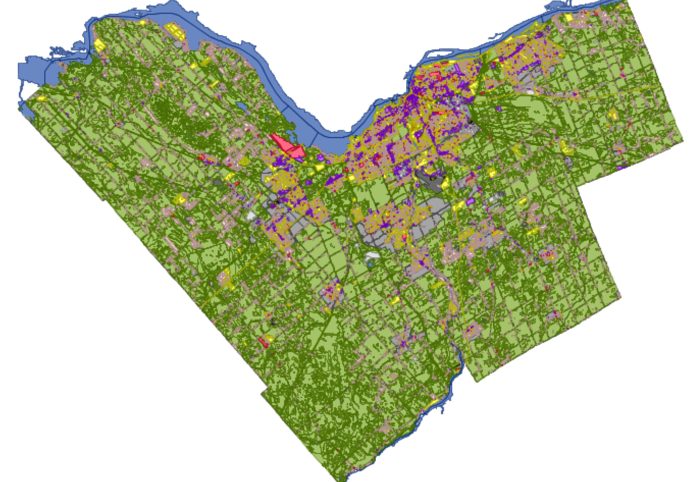
The Process
Obtaining OpenJUMP and data
Step 1: Downloading OpenJUMP
OpenJUMP can be downloaded through the following link [1] by clicking the green ‘Download’ button.
Step 2: Downloading the data
The Ottawa Thematic Data can be downloaded through the following link [2] by clicking the red 'Land Use 2010 - Direct Download' link.
Note: Since this data is from a licensed dataset, it is only available to Carleton students, staff and faculty.
Starting OpenJUMP and importing data
Step 3: Starting OpenJUMP
OpenJUMP starts up by clicking the ![]() icon, the main screen shown in Figure 1.2 should appear shortly after.
icon, the main screen shown in Figure 1.2 should appear shortly after.
Step 4: Importing the data
Adding files is done by using the folder icon circled in red as seen in Figure 1.2. In this case, we will be importing the 'LandUse_2010.shp' file which can be found where the previously downloaded data was saved. Right now would be a good time to save your project by clicking on the 'File' tab and then the 'Save Project As' button.
Note: it is important to save your project frequently to avoid losing any progress.
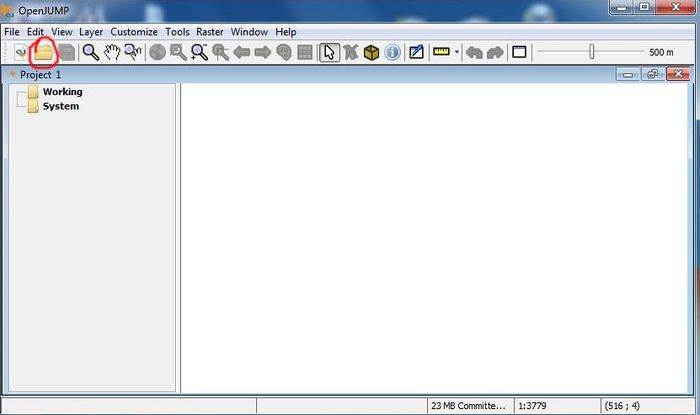
Manipulating the data
Step 5: Extracting the data
The 'LandUse_2010' data will appear as one single layer even though it consists of mulitple attributes. This results with the image being displayed in one single color, even though our goal is to portray each land use type by different colors. To achieve this, click on the 'Edit' tab, then scroll over 'Extract' before choosing the 'Extract Layer by attribute' button. In the pop-up window, select 'LU_2010' as the attribute. This will result with the creation of a new folder named 'Extract' in the content pane which shows each attribute as a single layer.
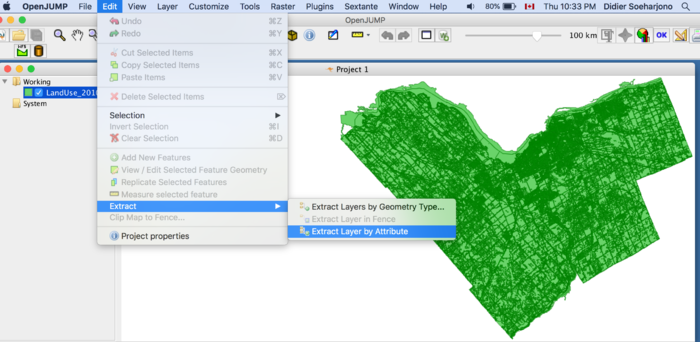
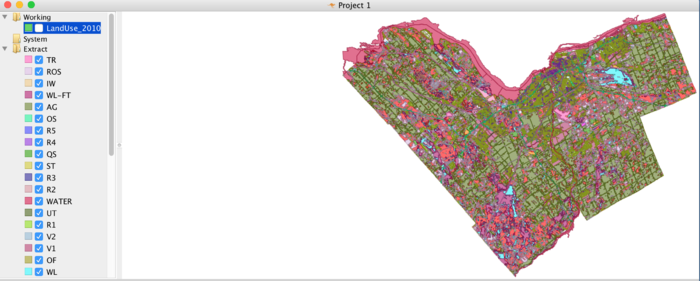
Step 6: Reclassifying land use layers
By referring to the 'LandUse_2010_Legend.xlsx' Microsoft Excel file that comes in the downloaded data folder, we can classify the land use layers into 9 different types. Each layers will be reclassified into the following categories:
- Residential:R1; R2; R3; R3-3; R4-x; R-4; R-5
- Commercial:C1; C2; C3; OF
- Industrial:M1; M2
- Institutional:I1; I2; I3; I3-r; I4; I5
- Recreational:RE-A; RE-A-s; RE-p; RE-p-s
- Utilities:TR; UT; COMM; ST
- Water:Water; IW
- Landcover:OS; AG; FT; QS; ROS; WL; WL-FT
- Other:V1; V2
To do so in OpenJUMP, we can select the appropriate layers for each category then right-click and choose the 'Combine selected layers' button. This will combine all the selected layers into a single one, which we will then rename the newly created 'Combined' layer to the appropriate category name by double-clicking on its label. This process will have to repeated until the 9 reclassified categories have been created and renamed.
Step 7: Changing the layers style
In order to change the color symbolization of the layers, we will start by selecting each reclassified layers one by one, followed by clicking on the 'Change styles' button (painting palette icon). In the pop-up window, click on the 'Colour theming' tab and then uncheck the 'Enable colour theming' box. Now return back to the 'Rendering' tab, before changing the 'Fill' to a more appropriate color for each reclassified layer.
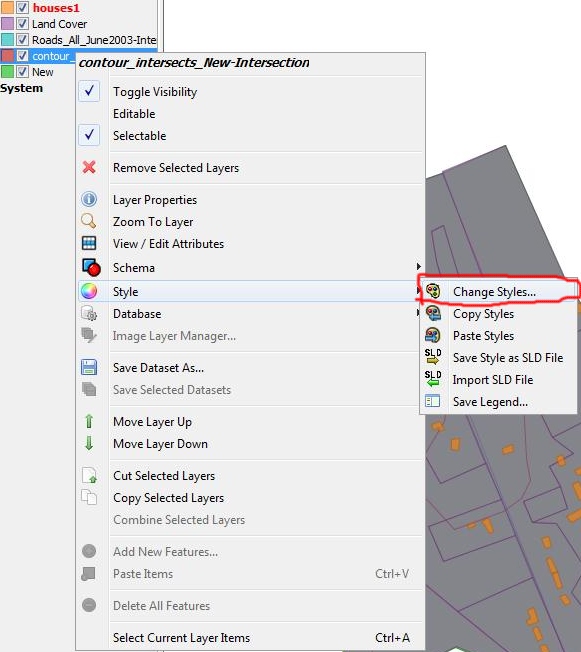
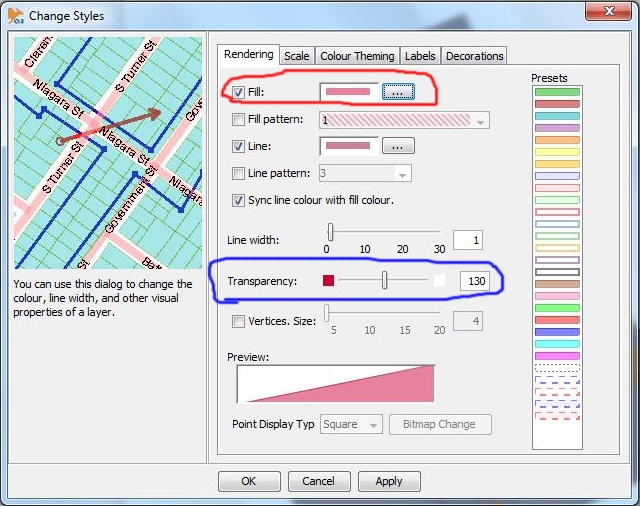
Once the colour theming is complete the output will be a final map product like Figure 2.8. This final map product makes it easy to interpret what is on the map in addition to being visually appealing.
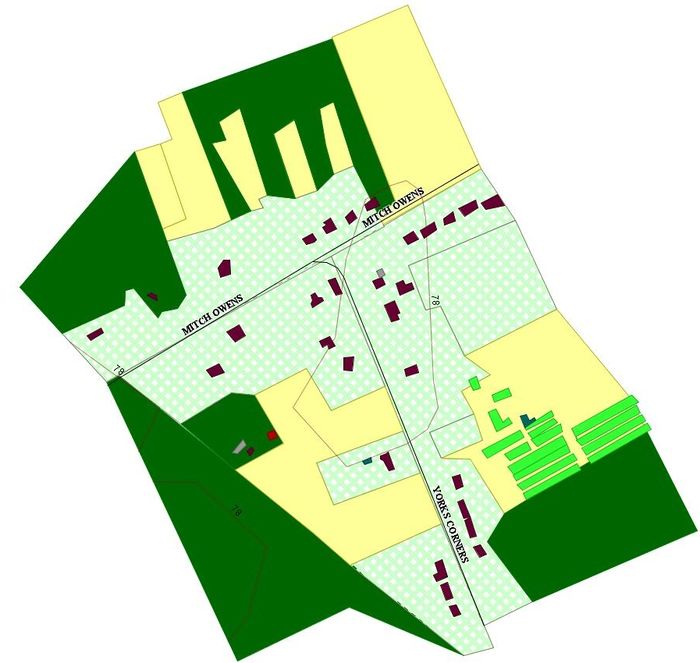
At this point adding a legend will help with interpreting the map. Right click the layer that would benefit from a legend (in the case of this project it will be for land use). Select Styles -> Save Legend (as shown in Figure 2.9). Save the legend somewhere memorable and then use the Add Files icon from Figure 1.2 to load in the Legend image. The image may end up far away from the map itself so use the method shown in Figure 1.4 to move it to the desired location. Once in place the end result should look like Figure 2.10 below.
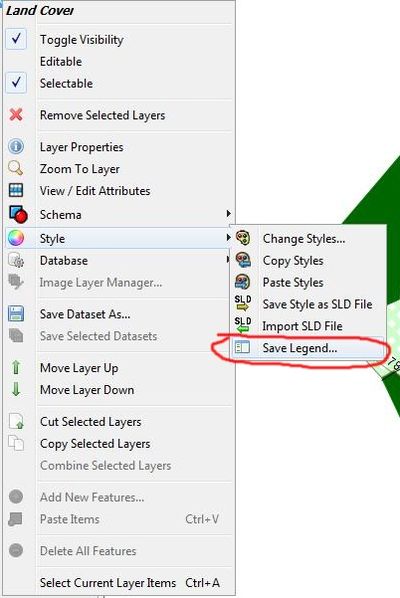

Styled Layer Descriptor
Since shapefiles in general will not store visual styles as soon as the mapping program is closed and reopened all of that work styling is wasted. Styled Layer Descriptors (SLD) retain style information for layer and can be built, imported and exported using OpenJUMP. These files are not only useful for maintaining style in OpenJUMP but since they are written in Extensible Markup Language (XML) they are universally useful for styling webmaps. To build an SLD simply right click on the layer in the table of contents and select Style->Save Style as SLD File (red circle in Figure 3.1). From there the SLD file is stored and can be imported for a layer at any point using the Style->Import SLD File option from the same menu (blue circle in Figure 3.1).
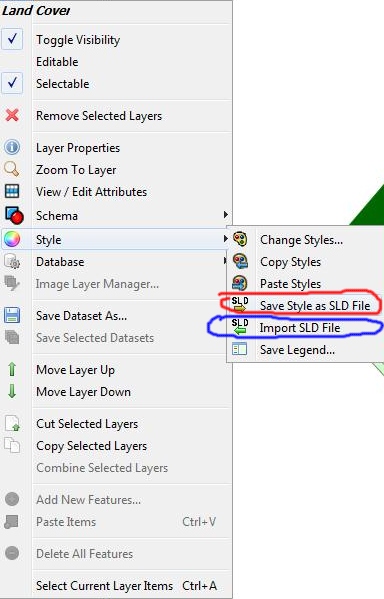
Conclusion
You now have a final map product and SLD files for styling. Try different styles as OpenJUMP has a really great variety.
